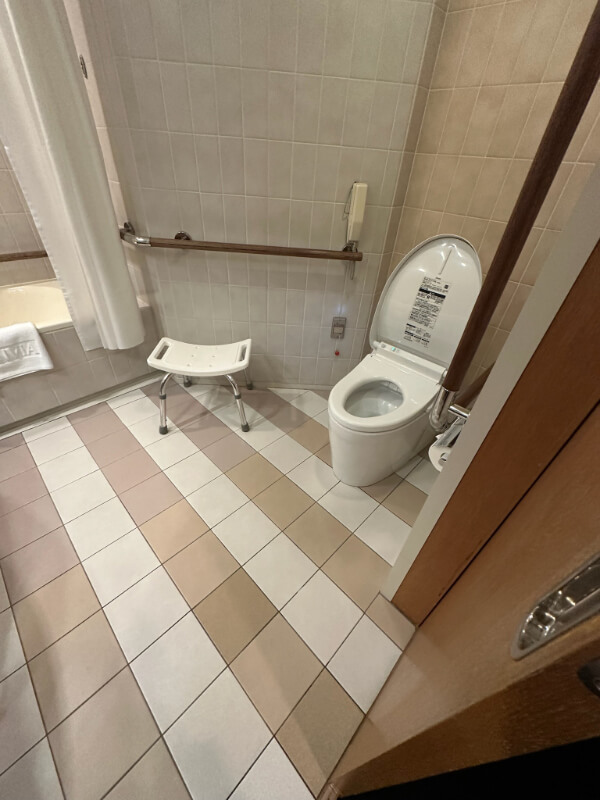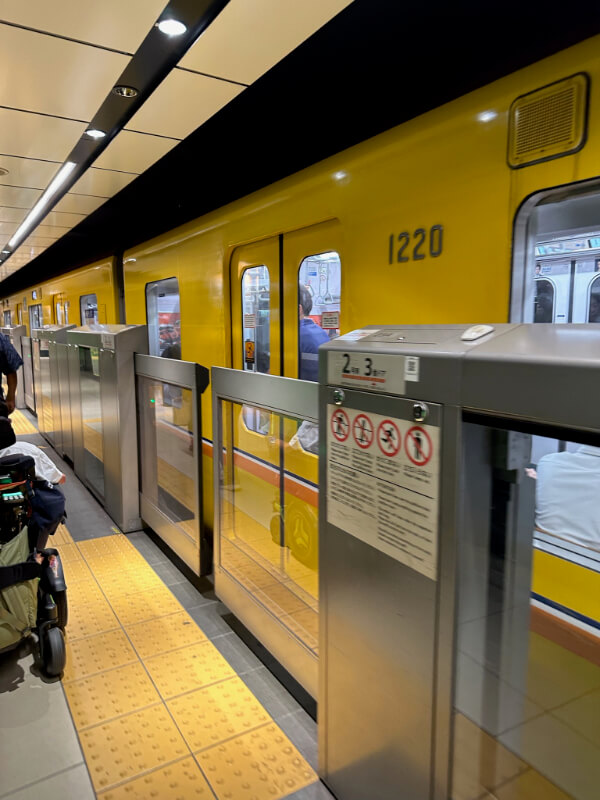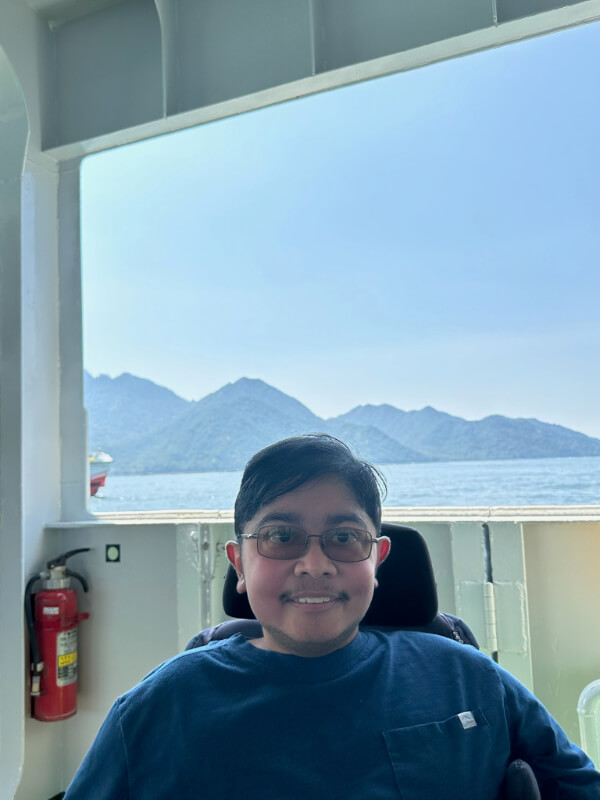By Tayjus Surampudi
Several years ago, I stumbled upon Accessible Japan and it opened my eyes to how accessible Japan is. It became a dream of mine to visit Japan and at the beginning of September, that dream became a reality. We worked with a tour company called Novaland Tours, which did an incredible job in terms of finding accessible transportation, booking hotels, and organizing tours. Over the course of my 10 days, I fell in love with the country and Japan became my favorite country.
The airport experience
My parents and I flew into Narita International Airport from LAX on United Airlines. The assistance upon arrival and in the airport was perhaps the best I’ve seen. The aisle chair was brought promptly, faster than any other airport. As I was assisted off the plane, I was so impressed to see that there was a little ramp between the plane door and the jetbridge. This was something I’d never seen in any other country and it made getting off the plane safer and more comfortable than being lifted in the aisle chair as is the case in most countries. I became even more impressed when I saw the airport staff transform the aisle chair into a wheelchair by attaching large wheels to the side of the aisle chair. Normally, in other countries, I would have to be transferred from the aisle chair to another wheelchair before finally being transferred to my power chair. Once my power chair arrived and I transferred into it, the assistance staff escorted us to immigration followed by baggage claim and then brought us to our driver.
We had a similarly pleasant experience on our return flight from Narita to Newark. When we checked in at the United Airlines counter, the staff was familiar with the process for tagging my power chair and the procedure for traveling with a wheelchair. When I fly, I always attach instructions for operating my chair and I even have a QR code that links to the manual for my power chair, the M3. I’m never sure if my instructions are being read so I was pleasantly surprised to see the United staff scan the QR code. When we arrived at the gate, the ramp agent and the airport staff to assist me with boarding were already waiting with aisle chair. The ramp agent then asked us to walk him through how to operate my chair and he even took videos of how to put the chair in manual mode and back to driving. I was then able to transfer into the aisle near the gate rather than at the door of the plane. I preferred this and because they had me boarding so early, it was much less stressful than usual.

Hotels
We stayed at the Asakusa View Hotel and the Hotel Granvia Kyoto, both of which were very nice and modern and in great central locations.

In both hotels, we stayed in barrier free rooms. These rooms were fairly spacious and I could easily move around the room. They didn’t quite have roll-in showers, but instead, there was a space next to the tub with a drain where I positioned my shower chair and could use the handheld shower. While this was not ideal and different from what I was used to, showering this way was not an issue and we were able to manage fine.

Getting Around
Rolling around Tokyo, Kyoto, and Osaka in my power chair was extremely easy. Sidewalks were spacious, smooth and had proper curb cuts everywhere.
For most of our sight-seeing, we used a wheelchair accessible vehicle service to get around. We used two different companies, one based in the Tokyo area and the other based in the Kyoto area. Both vehicles were large vans equipped with a lift and tie downs to secure my wheelchair. The two companies were extremely professional and provided incredible service. Using these services allowed us to cover a lot more each day than we could have using public transit. I was especially impressed by the vehicle in Tokyo. The lift platform itself had tie downs, which meant that once I was on the platform, I didn’t have to worry about driving into the vehicle or reversing back on the platform. We did experience one hiccup with transportation in Nara. In Nara, the van’s battery died so we were unable to use the vehicle to return to Kyoto. Fortunately, we were able to just take the Kintetsu rail back to Kyoto and the van was ready to use again that evening.

Public Transportation
Public transit was phenomenal and better than anywhere I’ve traveled. We traveled on the Shinkansen, the Kintetsu train, the ferry, tram and bus in Hiroshima, and the Tokyo metro. I particularly appreciated how clean the train station elevators were, especially compared to the train stations in the U.S., where the elevators smell like urine and the automatic barriers on the platform, which made me feel much safer when driving my chair on the platform. The train stations also had great wheelchair accessible bathrooms that were extremely clean and well maintained.

Taking the Shinkansen was such a smooth and pleasant experience. We took the Shinkansen three times: from Tokyo to Kyoto, Kyoto to Hiroshima, and Kyoto back to Tokyo. Upon arrival at the train station, we went to the assistance booth next to the entry gates and requested a ramp to enter the train. The station staff told us to wait off to the side and about 15 minutes before the train ‘s scheduled arrival time, a member of the station staff arrived with a portable folding ramp and escorted us to the elevator and to the designated boarding area for the accessible train car, Car 11. The staff quickly placed down the ramp and upon entering the train, we were greeted by the Shinkansen staff who directed us to our seats on the train. The Shinkansen was an extremely smooth ride especially compared to Amtrak in the U.S. About 5 minutes before we were to get off, the Shinkansen staff ushered us to the door so that we would be ready to disembark as soon as the train stopped. As soon as the train came to a stop and the doors opened, a member of the station staff placed down the folding ramp. After I got off the train, the station staff then walked us to the elevator for us to leave the platform.
My experience with taking the Kintetsu rail, the local train in Hiroshima, and the Tokyo metro were similar. Once we arrived at the station, we notified the staff that we would need a ramp and then the staff came over with the ramp and walked us to the boarding area. Upon arrival at our destination, a staff member then placed the ramp down for me to disembark.
In Hiroshima, we also took the ferry to Miyajima island, which was easy to board and a smooth ride, and then we took the tram to Peace Memorial Park. The tram was easy to use and had a small built-in ramp that could be folded out for a wheelchair user. The ramp didn’t quite align with the platform at the stop near the Atomic Bomb Dome, but I was easily able to clear the gap between the tram and the platform. Finally, we took the bus back from the Peace Museum to the train station and this was a pleasant experience. The bus was a standard accessible bus that lowered down and had a built in ramp and had tie downs for the chair.

Sightseeing
During our 10 days in Japan, we managed to pack a lot of sightseeing in, maybe even a bit too much. Every tourist attraction we visited had great accessibility with ramps and elevators in most places as well as wheelchair accessible bathrooms. In Tokyo, we visited the Shinjuku Gyoen National Garden, Meiji Jingu Shrine, Shibuya Crossing, Sensoji Temple, Nakamise Shopping Street, the Tokyo Skytree, Akihabara, and Ginza.
We also did a day trip from Tokyo to the Fuji Subaru Line 5th Station (unfortunately it was too cloudy to see Mt.Fuji), and Oshino Hakkai.
In Kyoto, we visited the Kiyomizu-dera Temple, Arashiyama Bamboo forest, Fushimi Inari Taisha Shrine, and the Gion area. In Kyoto, we were also able to attend a tea ceremony. This was a great experience, although the ramp to enter the teahouse was a bit steep, but it was nothing my power chair couldn’t handle.
From Kyoto, we did day trips to Nara, Osaka, and Hiroshima. On the way to Nara, we also visited the Horyu-ji Temple, which also had some steep ramps, but again it was nothing my power chair couldn’t handle. In Osaka, we visited Osaka Castle and Dotonbori.
Finally, in Hiroshima, we visited Miyajima Island, and the Hiroshima Peace Memorial Park including the Atomic Bomb Dome, the Children’s Peace Monument as well as the Hiroshima Peace Memorial Museum.
The people
We found people in Japan to be incredibly friendly, helpful, respectful, and accommodating. From the airport staff to our tour guides and drivers to the train station staff and hotel staff, everyone was incredibly professional and took pride in doing a great job. At restaurants, the staff went out of their way to accommodate me and on one occasion, the shop owner went out of her way to widen the entrance of the store by removing a part of the door. so that I could enter in my wheelchair. People also really appreciated and were amused by my attempts to speak Japanese. Perhaps the most important words I learned were the word for wheelchair, Kuruma-isu, the word for ramp, suropu, and the word for elevator, erebeta. The Accessible Japan page on essential phrases was an extremely helpful resource and I recommend that anyone traveling to Japan in a wheelchair take a look at this page.
Final Thoughts
Overall, my trip to Japan was incredible. Japan is a beautiful country with excellent accessibility and such friendly and helpful people. I strongly believe that everyone should visit Japan once in their lifetime!












Responses
Hi Tayjus
Thank you for sharing your experience
It was very helpful and informative
Especially that you provided information about wheelchair accessible vehicles and the transportation system
Thank you again